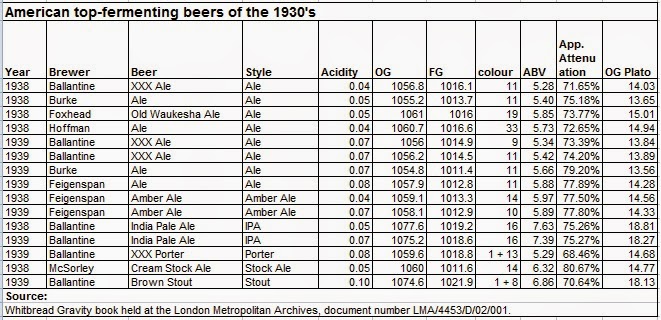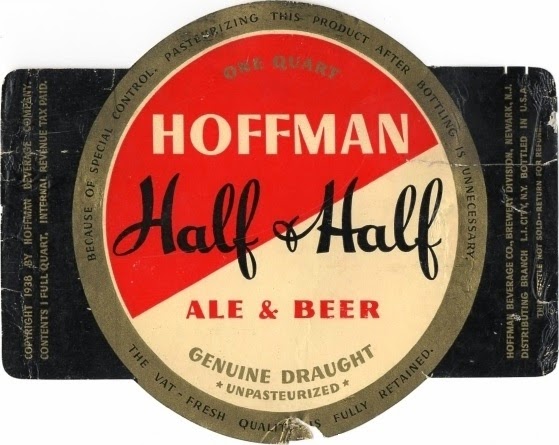Visit the Shut up about Barclay Perkins site
It’s now time to move on to the exciting world of American top-fermenting beers from before WW II.
Unsurprisingly, while the bottom-fermenting styles found their inspiration in Central Europe, the top-fermenters have their origins in the British Isles. At least most of them. There are two exceptions to this, which we’ll see in a moment.
Though the Wahls do differentiate between the American and British versions. Because, while the prototypes might have been British, in confirmation of my theory of beer style evolution, they began to mutate when transplanted to a new environment. Partly due to the raw materials available and advances in technology, but also to the regulatory regime in their new home. And WW I, with the huge changes it wrought on British brewing, only made the divergence between the beers on the two sides of the Atlantic greater.
We’ll be looking at this in more detail in a later post. But I will remark that the Wahls don’t seem to have noticed just how much British had transformed itself between 1914 and 1930.
I’ll begin with an overview. See if you can spot which type of American beer from the pre-Prohibition period has disappeared.
| 2. Top Fermentation |
| English Beer |
Mild ales |
| English Beer |
Stock ales |
| English Beer |
Porter |
| English Beer |
Stout |
| English Beer |
Cream ales |
| American Ale |
Cream ales |
| American Ale |
Sparkling ales |
| American Ale |
Stock ales |
| American Porter and Stout |
Porter and Stout |
| German Weiss Beer |
Weiss beer |
| American Weiss Beer |
Weiss beer type |
| Kentucky Common Beer |
Louisville |
"Beer from the Expert's Viewpoint" by Arnold Spencer Wahl and Robert Wahl, 1937, page 150.
Here’s some more detail:
“American Top Fermentation Beers
American Ales, Porter, Stout. Cream or sparkling ales arc quite lively, clear and sparkling, and quite pale. The American ales, like the English, are not produced for body, yet they should conform in a measure to the light lager beers of the Pilsener or Dortmunder type in general characteristics. Being fermented with top yeast this alone gives them variation from the lager beer type. These ales as are also the American stock ales are carbonated and filtered. The cream ale is finished in about two to three weeks, the stock ale in about four to six weeks without regard to secondary fermentation. Cream ale is brewed with an original extract of wort of about 14, stock ale with 16 to 18. The cream ale has an alcoholic content of about 5 per cent by weight, the stock ale about 6 per cent by weight. The Balling of the finished products is about 3 to 4 degrees on the Balling saccharometer. Usually the finished ales are dry-hopped, that is, fresh hops of a good quality are added to the storage tank. In the Wahl method the finished beers are run through a chamber charged with hops for cold extraction of the highly soluble hop oils.
American Porter and Stout. The porter is brewed in at about 15 per cent original extract, the stout from 18 to 21. They are quite dark. They are brewed like the ales but are not dry hopped.
American Weiss Beer. This beer is brewed from wheat and barley malt according to methods described for Berliner Weiss Beer.”
"Beer from the Expert's Viewpoint" by Arnold Spencer Wahl and Robert Wahl, 1937, pages 156 - 157.
It looks like Cream Ale has replaced Present Use Ale. A beer produced quickly for immediate consumption. While Stock Ale, lacking a secondary fermentation, isn’t really Stock Ale. Four to six weeks is pretty quick. It really just looks like a slightly stronger version of Cream Ale.
What interests me most is that both Cream and Stock Ales were dry-hopped in the conditioning tank. I wonder how long this continued? British brewers didn’t generally dry-hop Porter, but did their Stouts. I assume that American brewers must have once dry-hopped them, too. When and why did they stop?
How accurate are the gravities? I’m lucky enough to have a reasonable number of analyses of US Ales from the 1930’s:
| American top-fermenting beers of the 1930's |
| Year |
Brewer |
Beer |
Style |
Acidity |
OG |
FG |
colour |
ABV |
App. Attenuation |
OG Plato |
| 1938 |
Ballantine |
XXX Ale |
Ale |
0.04 |
1056.8 |
1016.1 |
11 |
5.28 |
71.65% |
14.03 |
| 1938 |
Burke |
Ale |
Ale |
0.05 |
1055.2 |
1013.7 |
11 |
5.40 |
75.18% |
13.65 |
| 1938 |
Foxhead |
Old Waukesha Ale |
Ale |
0.05 |
1061 |
1016 |
19 |
5.85 |
73.77% |
15.01 |
| 1938 |
Hoffman |
Ale |
Ale |
0.04 |
1060.7 |
1016.6 |
33 |
5.73 |
72.65% |
14.94 |
| 1939 |
Ballantine |
XXX Ale |
Ale |
0.07 |
1056 |
1014.9 |
9 |
5.34 |
73.39% |
13.84 |
| 1939 |
Ballantine |
XXX Ale |
Ale |
0.07 |
1056.2 |
1014.5 |
11 |
5.42 |
74.20% |
13.89 |
| 1939 |
Burke |
Ale |
Ale |
0.07 |
1054.8 |
1011.4 |
11 |
5.66 |
79.20% |
13.56 |
| 1939 |
Feigenspan |
Ale |
Ale |
0.08 |
1057.9 |
1012.8 |
11 |
5.88 |
77.89% |
14.28 |
| 1938 |
Feigenspan |
Amber Ale |
Amber Ale |
0.04 |
1059.1 |
1013.3 |
14 |
5.97 |
77.50% |
14.56 |
| 1939 |
Feigenspan |
Amber Ale |
Amber Ale |
0.07 |
1058.1 |
1012.9 |
10 |
5.89 |
77.80% |
14.33 |
| 1938 |
Ballantine |
India Pale Ale |
IPA |
0.05 |
1077.6 |
1019.2 |
16 |
7.63 |
75.26% |
18.81 |
| 1939 |
Ballantine |
India Pale Ale |
IPA |
0.07 |
1075.2 |
1018.6 |
16 |
7.39 |
75.27% |
18.27 |
| 1939 |
Ballantine |
XXX Porter |
Porter |
0.08 |
1059.6 |
1018.8 |
1 + 13 |
5.29 |
68.46% |
14.68 |
| 1938 |
McSorley |
Cream Stock Ale |
Stock Ale |
0.05 |
1060 |
1011.6 |
14 |
6.32 |
80.67% |
14.77 |
| 1939 |
Ballantine |
Brown Stout |
Stout |
0.10 |
1074.6 |
1021.9 |
1 + 8 |
6.86 |
70.64% |
18.13 |
| Source: |
| Whitbread Gravity book held at the London Metropolitan Archives, document number LMA/4453/D/02/001. |

The OG and ABW of the Ales are both lower than claimed: they average 14.19º Plato and 4.49% ABW. I can’t say much about the Stock Ales, as I’ve only one example, but that, too, has an OG lower than claimed by the Wahls. They are right about the FG’s, which are mostly between 3º and 4º Plato.

I’ve just noticed something odd. There’s no mention of IPA in the book, despite Ballantine’s being a major brand at the time. Perhaps the Wahls just considered them examples of Stock Ales. Not so crazy, as the original British IPAs were Stock Ales. And Ballantine IPA was matured in wooden vats.
I’m very surprised that the Weissbier brewed in the USA wasn’t the Bavarian type but Berliner. I’d love to know if it was as sour as the German variety. And when it was last brewed in the USA.
Here’s the other top-fermenter not of British origin: the indigenous Kentucky Common:
“Kentucky Common Beer. This type of beer is brewed with a top fermenting yeast and is handled thereafter similar to California Steam Beer. The beer is run directly from the fermenter into the trade package (barrels) and krausened, finings added and the barrels bunged and then delivered in this condition to the dispensing place where it is permitted to clarify before serving. The difference between the California Steam Beer and Kentucky Common Beer is in the type of yeast used: in the first, a bottom yeast, in the second, a top yeast. The Kentucky Common Beer yeast is developed from lager beer yeast by high fermenting temperatures. This yeast then develops a percentage of lactic acid organisms which cause the final brew to be somewhat tart to the taste, the whole having a particularly peculiar flavor which became quite popular in the Southern States. This beer is supplied mainly from Louisville, Kentucky. Common beer is brewed today using the common beer yeast but krausened in finishing tanks and then filtered. It is supplied in barrels and in bottles.”
"Beer from the Expert's Viewpoint" by Arnold Spencer Wahl and Robert Wahl, 1937, page 153.
I’m intrigued by the comparison with California Steam Beer, another indigenous American style. But the stuff about lactic acid formation goes against the latest research into the style, which refutes claims it was sour.
Not sure what I’ll bore you with next from the book. Perhaps the comparison of German and British beer.
More...







 Reply With Quote
Reply With Quote